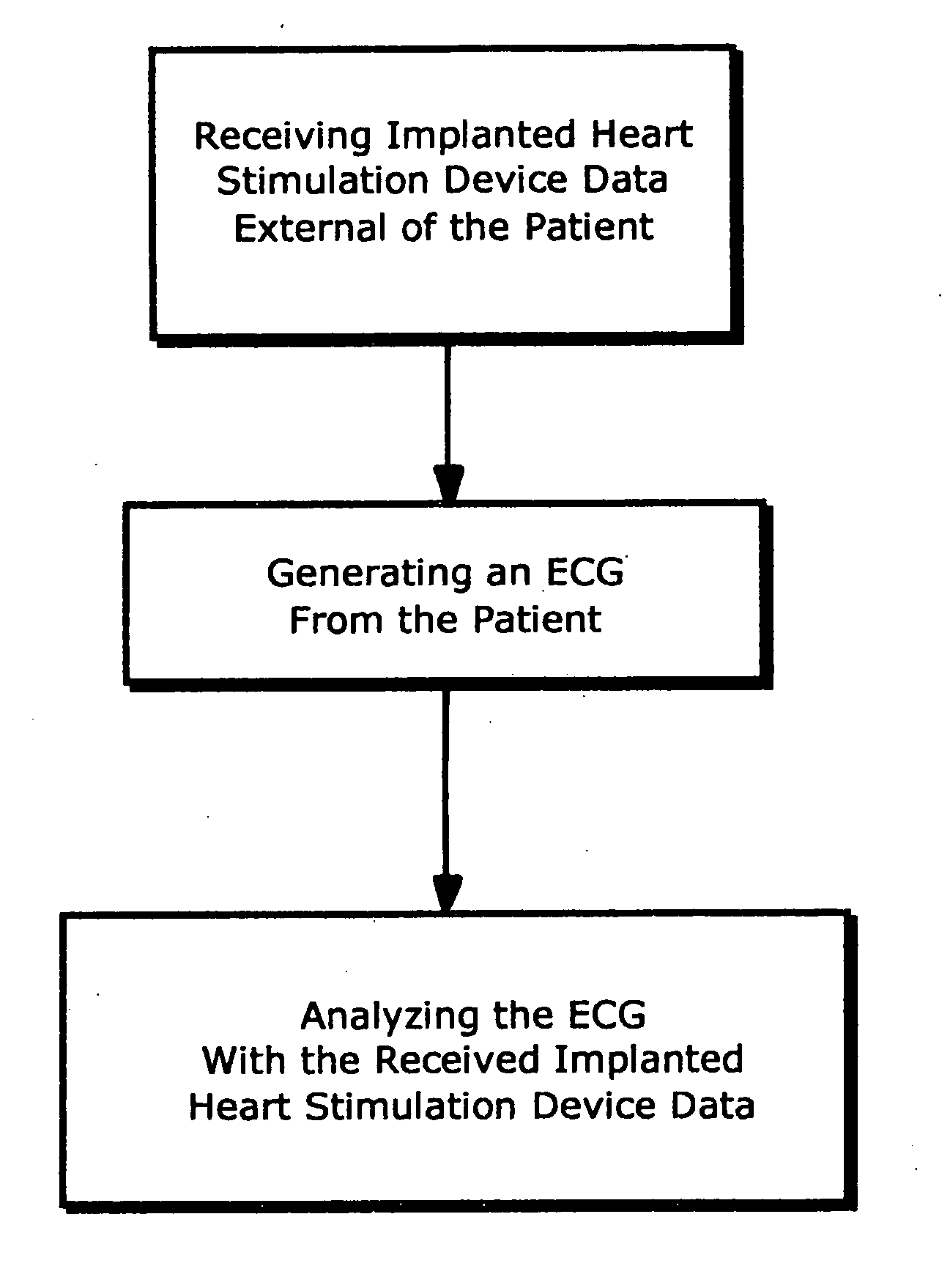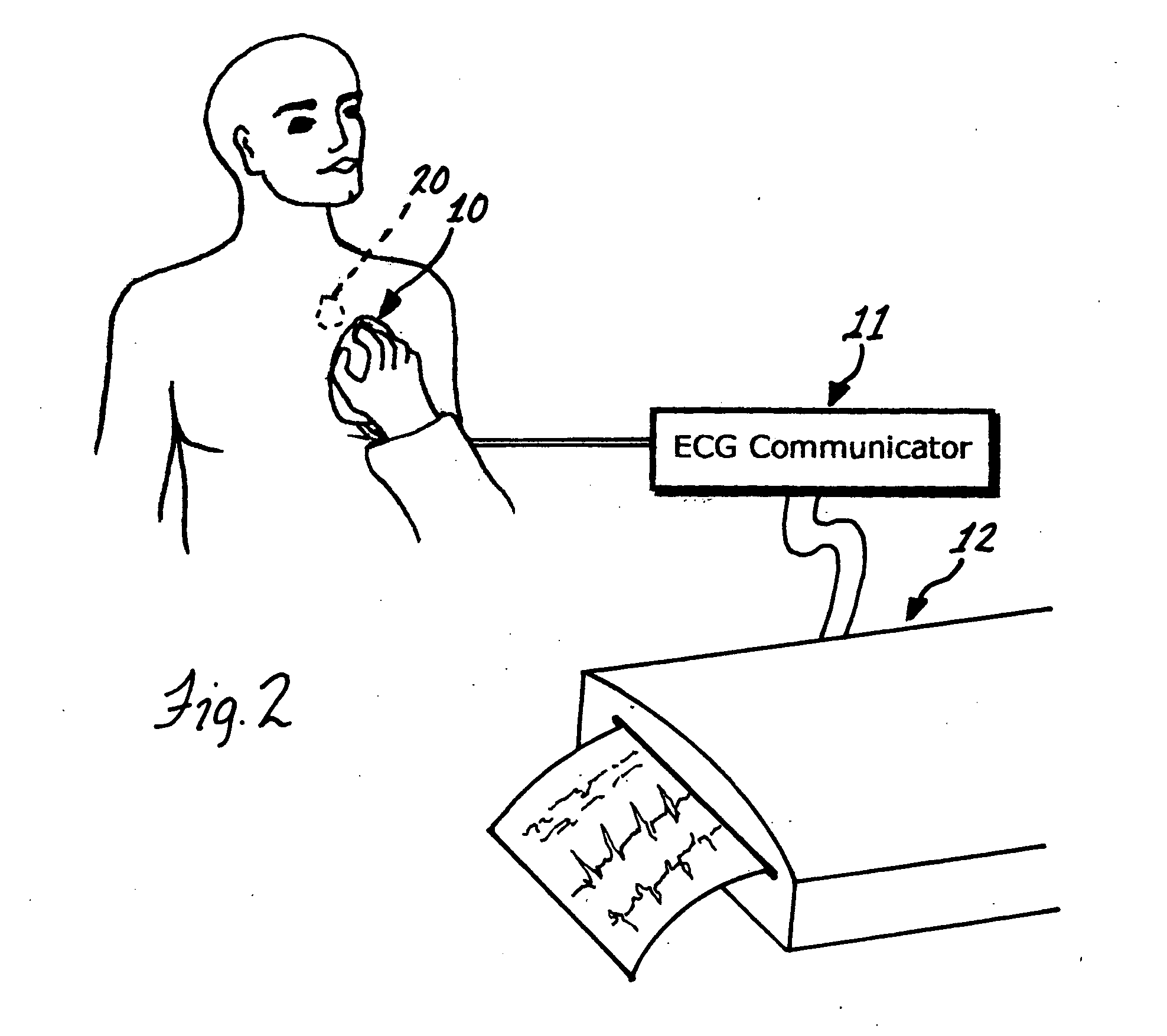ECG diagnostic system and method
a technology of ecg and diagnostic system, which is applied in the field of system and method of ecg diagnosis for patients with implanted heart stimulation devices, can solve problems affecting patient safety and care, and achieve the effects of preventing life-threatening bradyarrhythmias, eliminating erroneous diagnoses of conduction block, axis deviation, and myocardial infarction, and improving interpretation of repolarization changes associated with ecg
- Summary
- Abstract
- Description
- Claims
- Application Information
AI Technical Summary
Benefits of technology
Problems solved by technology
Method used
Image
Examples
second embodiment
[0034] A second embodiment, one which permits a more detailed interrogation of an implanted pacemaker, can be described with reference to FIG. 2. A patient is shown in whom a pacemaker 20 has been implanted. Also shown is an electromagnetic wand 10 that is designed such that it can be placed on the skin directly over the implanted pacemaker. The wand and pacemaker each have coils of wire contained within them that serve as antennas in close proximity to each other when the wand is properly placed. In operation, the button on the wand is depressed to command a transmission by the pacemaker. The pacemaker receives the command and transmits data back to the wand. These data may include, but are not limited to: pacemaker manufacturer and type; pacing mode, whether DDDR, DDD, DDIR, DDI, VVIR, VVI, AAIR, AAI, or other; any special features that have been programmed on, such as antitachycardia, rate responsive, autocapture, mode switch, PVC response, etc; pacing parameters including lower ...
third embodiment
[0037] In a third embodiment, the wand is eliminated and the pacemaker transmits status data and marker signal directly to the ECG communicator by radio frequency (RF) transmission using the pacemaker power source. The distance between the patient and said ECG communicator in this embodiment could be, for example, 10 feet. The transmitter frequency could be, for example, 420 MHz, a frequency designated by FCC for medical applications. A command to transmit said data and signal is transmitted directly from the ECG communicator to the implanted pacemaker, using the same frequency.
fourth embodiment
[0038] In a fourth embodiment, the pacemaker status and marker data are not transmitted, but are superimposed on a suitable carrier and delivered directly to the pacemaker intracardiac electrodes. The signal power is well beneath that of a pacing stimulus and has no physiological effect. However, the signal can be detected using electrodes on the skin, including in particular the standard ECG electrodes. In this embodiment, the cable from the standard ECG electrodes is connected directly to the ECG communicator, which has additional receiver circuitry for separating the high-frequency carrier-based status and marker signal from the lower-frequency electrocardiographic signal. The status data, marker signal, and ECG are then delivered to the ECG machine for printing.
[0039] As is apparent, the systems disclosed herein all include information or data acquiring means that allow an electrocardiographer to easily acquire information or data relating to the implanted heart stimulator devic...
PUM
 Login to View More
Login to View More Abstract
Description
Claims
Application Information
 Login to View More
Login to View More - R&D
- Intellectual Property
- Life Sciences
- Materials
- Tech Scout
- Unparalleled Data Quality
- Higher Quality Content
- 60% Fewer Hallucinations
Browse by: Latest US Patents, China's latest patents, Technical Efficacy Thesaurus, Application Domain, Technology Topic, Popular Technical Reports.
© 2025 PatSnap. All rights reserved.Legal|Privacy policy|Modern Slavery Act Transparency Statement|Sitemap|About US| Contact US: help@patsnap.com



